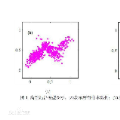Deep clustering was applied to unlabeled, automatically detected signals in a coral reef soundscape to distinguish fish pulse calls from segments of whale song. Deep embedded clustering (DEC) learned latent features and formed classification clusters using fixed-length power spectrograms of the signals. Handpicked spectral and temporal features were also extracted and clustered with Gaussian mixture models (GMM) and conventional clustering. DEC, GMM, and conventional clustering were tested on simulated datasets of fish pulse calls (fish) and whale song units (whale) with randomized bandwidth, duration, and SNR. Both GMM and DEC achieved high accuracy and identified clusters with fish, whale, and overlapping fish and whale signals. Conventional clustering methods had low accuracy in scenarios with unequal-sized clusters or overlapping signals. Fish and whale signals recorded near Hawaii in February-March 2020 were clustered with DEC, GMM, and conventional clustering. DEC features demonstrated the highest accuracy of 77.5% on a small, manually labeled dataset for classifying signals into fish and whale clusters.
翻译:深海嵌入群集(DEC)利用信号的固定长功率光谱谱学到潜在特征和形成分类组群;人工挑选的光谱和时间特征也提取出来,并用高斯混合模型和常规集束集成;DEC、GMM和常规集束用随机带宽、持续时间和SNR对鱼脉搏(鱼)和鲸歌(鲸)的模拟数据集进行了测试。 GMM和DE都取得了很高的准确性,并查明了鱼类、鲸鱼和重叠鱼类和鲸鱼信号群群集;在规模不均或重叠信号的情况下,常规集聚方法的准确性较低;2020年2月至3月在夏威夷附近记录的鱼类和鲸鱼信号与DEC、GM和常规集聚集在一起。



